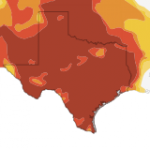For Texas Ranchers, the Grass Isn’t Always Greener

Photo by Scott Olson/Getty Images
Victoria Hogue helps to move cattle into pens after they had been sold at the Abilene Livestock Auction in July 2011. The drought caused shortages of grass, hay and water forcing ranchers to thin their herds.
Last year’s drought dried up hay fields, sent feed prices through the roof and forced many Texas ranchers to sell off large portions of their herds. And while winter rains helped ease the drought in Central and East Texas, they weren’t enough to wipe it out completely.
Yes, grass initially came back on the ranches of Central and East Texas, but it’s been a dry few months. “The hay fields aren’t doing any good at all,” says Elgin rancher Brent Johnson. “I mean, you know, you’re lucky to get a 50 percent production off of ’em at best, and that’s probably even stretching it.” But because there are less cows this year after last year’s sell-off, the little hay production Johnson does have can cover his herd for now.
“Most of the state is out of exceptional drought now,” says Gene Hall with the Texas Farm Bureau. “But the real problem is going to be feed, growing enough grass, [and] putting enough hay away to matter.”
Some think the state’s cattle industry may never fully recover from the drought. But Hall says the cattle business is cyclical. “You can track it over time,” Hall says. “The beef economists, the cattle economists can look at it and show you okay, cattle numbers will build to the point where prices decline, they sell off, and then they start building again. Ranchers want to be building their herds now.”
Hall says the weather isn’t cooperating right now, but change may be in the works. Bob Rose, meteorologist for the Lower Colorado River Authority, says this summer won’t be as hot as last.
“We are going to get some periods of showers coming in off the gulf, where we could get anywhere between light to moderate rain off of each one of these little waves,” Rose says. “Last summer we didn’t see anything like that.”
Rose says the summer high pressure system that made the drought so bad last year has moved on – at least for now.
And what of West Texas? For that part of the state, drought relief has been slow in coming. But Rose sees room for hope. “For West Texas, I think they’re going to actually start seeing more frequent rains, from now on through August and into September, as the weather patten out there changes.” Rose says this pattern in West Texas is known as the “summer monsoon,” and some years it’s more frequent than others. “This year is actually shaping up to be probably slightly above normal,” Rose says, “where we’re going to see a lot more of the afternoon and evening thunderstorms across West Texas and into New Mexico. And that’s good news for them because that area is so dry.”




